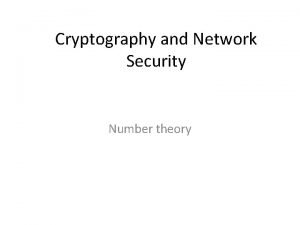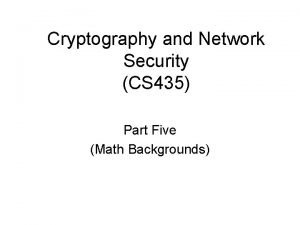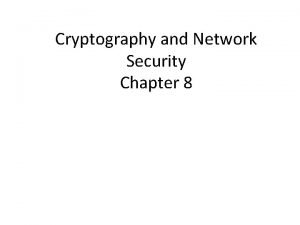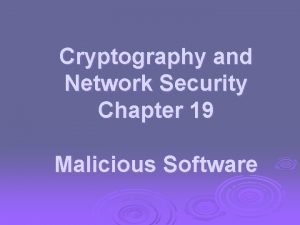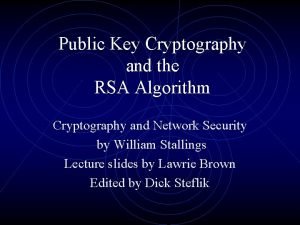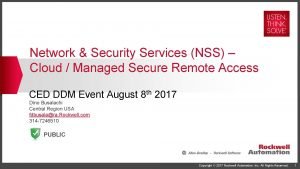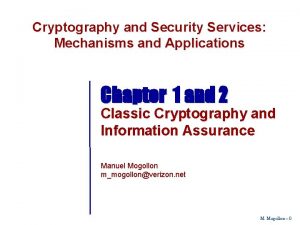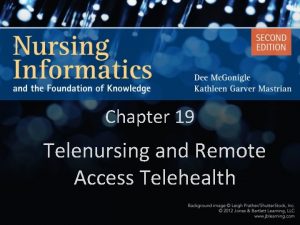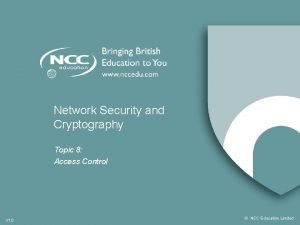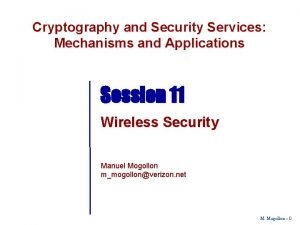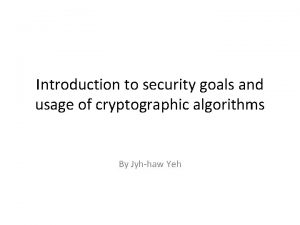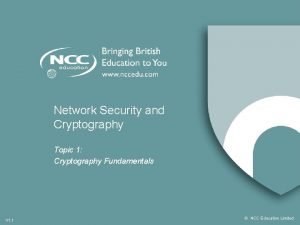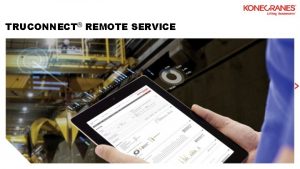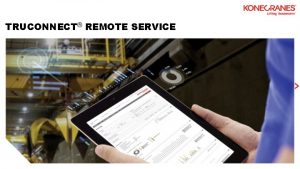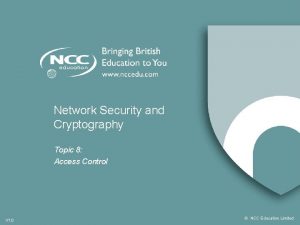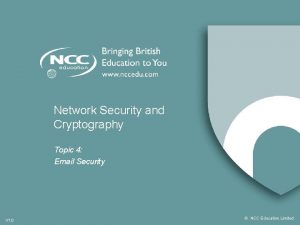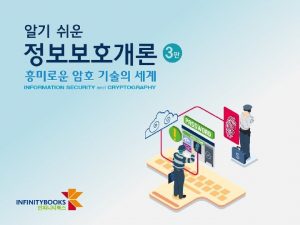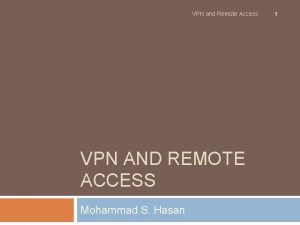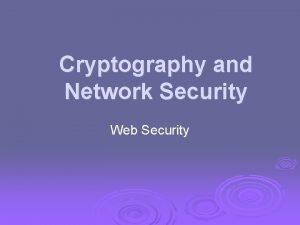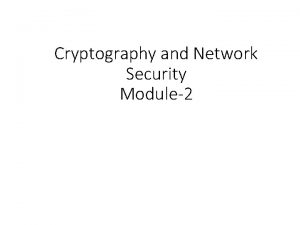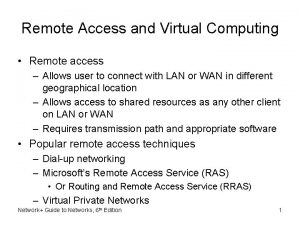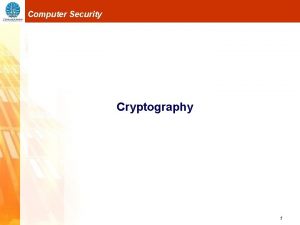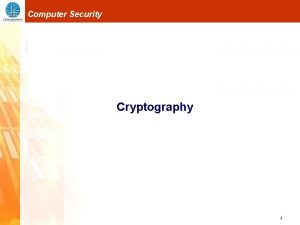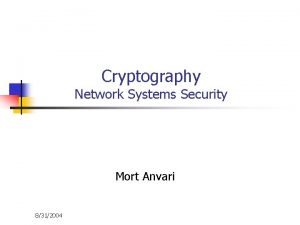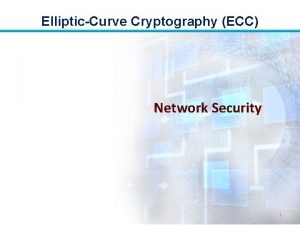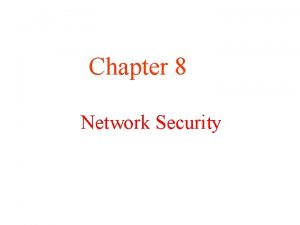Network Security and Cryptography Topic 11 Remote Access


































- Slides: 34

Network Security and Cryptography Topic 11: Remote Access V 1. 0 © NCC Education Limited

Network Security and Cryptography Topic 11 – Lecture 1: Introduction to Remote Access & Web Applications V 1. 0 © NCC Education Limited

Remote Access Topic 11 - 11. 3 Scope and Coverage This topic will cover: • Alternative remote access technologies: - Web applications - Remote desktops V 1. 0 © NCC Education Limited

Remote Access Topic 11 - 11. 4 Learning Outcomes By the end of this topic students will be able to: • Configure access control mechanisms • Select an appropriate remote access solution V 1. 0 © NCC Education Limited

Remote Access Topic 11 - 11. 5 What is Remote Access? • Accessing a computer where the user does not have physical access to it - Remote control of a computer - Using another device - Over a network, e. g. the Internet • A common example is the remote troubleshooting services offered by computer manufacturers V 1. 0 © NCC Education Limited

Remote Access Topic 11 - 11. 6 Why Have Remote Access? • Allows staff to work from any location – they are no longer required to be physically in the office - Home working - Out of hours working - Mobile staff • Has become a critical part of many modern businesses V 1. 0 © NCC Education Limited

Remote Access Topic 11 - 11. 7 Uses of Remote Access • Comes under two categories: - Accessing files remotely - Accessing applications remotely • By accessing files a remote user can transfer any individual files they need whilst working remotely • By accessing applications the remote user can use software on the network and therefore also process files and data in the same way as if they were in the workplace V 1. 0 © NCC Education Limited

Remote Access Topic 11 - 11. 8 Remote Application Architecture • In order to create remote access facilities an understanding of the application architecture is necessary • Three general models: - Client/Database - Client/Server - Web-based V 1. 0 © NCC Education Limited

Remote Access Topic 11 - 11. 9 Client/Database Architecture • Complete applications are installed on the client computer - Fat clients • Client connects to a database via a network • Data for applications is held on the database • Usually used where there is only a small number of clients V 1. 0 © NCC Education Limited

Remote Access Topic 11 - 11. 10 Client/Server Architecture • Typically has a stripped down version of applications installed on the client - Sufficient to connect to the server application • A full version of the software is installed on the server • Business logic rules are applied at the server and a connection created to the database • Example is mail client such as MS Outlook V 1. 0 © NCC Education Limited

Remote Access Topic 11 - 11. 11 Web-based Architecture • • • Web browser is used as the client Requires minimal software on the client computer Interacts with web server Provides web-based user interface Server may communicate with other application servers to provide functionality - These are usually on other hardware • Results are displayed in the web browser • E. g. webmail V 1. 0 © NCC Education Limited

Remote Access Topic 11 - 11. 12 Remote Access Technologies • A number of means of gaining remote access, for example: - Virtual Private Network (VPN) Remote Desktop Connection (RDC) Application Hosting Web-based applications • There are implications to consider: - Security - Bandwidth requirements V 1. 0 © NCC Education Limited

Remote Access Topic 11 - 11. 13 Virtual Private Network (VPN) • Secure tunnel between remote user and internal network • Once session is created user can pass data in/out of network • Limits due to available bandwidth - User or network end • Works well with web-based applications V 1. 0 © NCC Education Limited

Remote Access Topic 11 - 11. 14 Remote Desktop Connection (RDC) • Applications are hosted on a remote server • Appears as though screenshots have been sent to the client • Keyboard and mouse inputs are forwarded to the server • Results are shown in the screenshots that are returned to the client • Uses a constant and relatively small amount of bandwidth V 1. 0 © NCC Education Limited

Remote Access Topic 11 - 11. 15 Application Hosting • Application hosting involves using an external partner to host applications on their servers • Removes the need for internal IT departments to manage the architecture, servers and applications • Use of software and hosting management is via the external partner who charges for this service • The remote access is to this external partner’s servers, whether from inside the office or from a remote location V 1. 0 © NCC Education Limited

Remote Access Topic 11 - 11. 16 Web-based Applications • Clients do not require any dedicated software other than a standard web browser • Data passes over the Internet • Data transfer is encrypted • Can be provided as Software-as-a-Service (Saa. S) - Software vendors provide access to the software via the Internet V 1. 0 © NCC Education Limited

Remote Access Topic 11 - 11. 17 General Security Considerations • Security best practice should be followed: - V 1. 0 Firewalls Anti-virus software Updates and patches Security policies and procedures Staff training IDS Vulnerability scanning Separating web server, database server, etc. © NCC Education Limited

Network Security and Cryptography Topic 11 – Lecture 2: Remote Desktops V 1. 0 © NCC Education Limited

Remote Access Topic 11 - 11. 19 Remote Desktop • Allows applications to be run on a remote server but displayed locally • Can be achieved via software installed on the client or via a feature provided by the OS • May be command line applications • May be applications with a graphical user interface (GUI) • There are many OS that provide this functionality V 1. 0 © NCC Education Limited

Remote Access Topic 11 - 11. 20 Display Data Remotely • The controlling computer displays the image received from the controlled computer • This image is updated: - At regular intervals - Or when a change on screen is noted by the software • The controlling computer transmits input from its own keyboard or mouse to the controlled computer • The software implements these actions on the controlled computer V 1. 0 © NCC Education Limited

Remote Access Topic 11 - 11. 21 Display Data Remotely • The controlled computer acts as though these input actions were operated directly on itself • Any changes to the display as a result of these actions are transmitted back to the controlling computer • The controlling computer then displays this new display image on its screen • Input devices and screen on the controlled computer may be disabled V 1. 0 © NCC Education Limited

Remote Access Topic 11 - 11. 22 A Warning!! • Attackers have used remote access software to gain control of many computers • A typical scenario involves the user receiving a telephone call from someone pretending to be a legitimate corporation • They offer to fix your computer remotely • Once the remote access is allowed they use the computer for other purposes V 1. 0 © NCC Education Limited

Remote Access Topic 11 - 11. 23 Remote Desktop Protocols • There a number of protocols that may be used for remote desktop applications, including: - Virtual Network Computing (VNC) Remote Desktop Protocol (RDP) Apple Remote Desktop (ARD) Independent Computing Architecture (ICA) Appliance Link Protocol (ALP) • We will look at the first two in a little detail V 1. 0 © NCC Education Limited

Remote Access Topic 11 - 11. 24 Virtual Network Computing (VNC) • A graphical desktop sharing application • Provides remote access to a GUI • Transmits keyboard and mouse actions in one direction • Transmits graphical screen updates in the other direction • Original source code and many derivative packages are open source V 1. 0 © NCC Education Limited

Remote Access Topic 11 - 11. 25 Platform Independence • VNC is platform independent • A VNC viewer can connect to a VNC server using a different operating system • Multiple clients can connect to the same VNC server at the same time • VNC clients and servers are available for most GUI based operating systems V 1. 0 © NCC Education Limited

Remote Access Topic 11 - 11. 26 VNC Components • VNC server is the program on the server that allows the client to take control of it • VNC client (also known as the viewer) is the program that controls the server • The remote framebuffer (RFB) protocol sends simple graphic messages to the client and input actions to the server • The machine with the VNC server does not have to have a physical display V 1. 0 © NCC Education Limited

Remote Access Topic 11 - 11. 27 Framebuffer • A memory buffer • Drives video output display • Stores information on the colour value of every pixel in a display • Used in all systems that use windows • Information can be transmitted storing the colour and position of each pixel in a rectangle V 1. 0 © NCC Education Limited

Remote Access Topic 11 - 11. 28 The RFB Protocol • RFB sends information regarding rectangles of screen display • The colour information of rectangles for display are transmitted as a framebuffer • Includes compression techniques and security features • Client uses port 5900 for server access • Server may connect in listening mode on port 5500 V 1. 0 © NCC Education Limited

Remote Access Topic 11 - 11. 29 VNC Security • VNC does not use plaintext passwords • But it is not very secure • Open to sniffing attacks • Can be tunnelled over SSH or VPN connection for enhanced security • There are SSH clients for most platforms V 1. 0 © NCC Education Limited

Remote Access Topic 11 - 11. 30 Remote Desktop Protocol (RDP) • Microsoft protocol • Provides a GUI to another computer - Remote display - Remote input • Supports a number of technologies • Supports a number of LAN protocols • An extension of the ITU T. 120 family of protocols • Clients exist for most operating systems V 1. 0 © NCC Education Limited

Remote Access Topic 11 - 11. 31 RDP Operation • RDP uses its own video driver to convert rendering information into packets • Sends them to the client via the network • RDP receives rendering data at client and converts into Windows graphics device interface (GDI) calls • Mouse/keyboard events are sent from client to server • RDP uses its own on-screen events driver to receive these events V 1. 0 © NCC Education Limited

Remote Access Topic 11 - 11. 32 RDP Features • RDP offers many features: - V 1. 0 Encryption Bandwidth reduction Roaming disconnect Clipboard mapping Print redirection Sound redirection Support for 24 bit colour Smart Card authentication © NCC Education Limited

Remote Access Topic 11 - 11. 33 References • Sybex, (2001). Networking Complete. 2 nd Edition. John Wiley & Sons. • Tanenbaum, A. S. (2003). Computer Networks. 4 th Edition. Prentice Hall. • Microsoft Developer Network, http: //msdn. microsoft. com/en-us/library/aa 383015. aspx V 1. 0 © NCC Education Limited

Remote Access Topic 11 - 11. 34 Topic 11 – Remote Access Any Questions? V 1. 0 © NCC Education Limited
 Wireless security in cryptography and network security
Wireless security in cryptography and network security Modulo table
Modulo table Security mechanisms in cryptography
Security mechanisms in cryptography Number theory in cryptography and network security
Number theory in cryptography and network security Firewall in cryptography and network security
Firewall in cryptography and network security Authentication in cryptography and network security
Authentication in cryptography and network security Intruders in cryptography and network security
Intruders in cryptography and network security Primitive root of a number in cryptography
Primitive root of a number in cryptography Cryptography and network security 6th edition pdf
Cryptography and network security 6th edition pdf Cryptography and network security pearson
Cryptography and network security pearson Source
Source Cryptography and network security 4th edition
Cryptography and network security 4th edition Fermat's theorem in cryptography and network security
Fermat's theorem in cryptography and network security Finite fields in cryptography and network security
Finite fields in cryptography and network security Digital signature in cryptography and network security
Digital signature in cryptography and network security Gcd(1970,1066)
Gcd(1970,1066) Pgp in cryptography and network security
Pgp in cryptography and network security Euler's theorem in cryptography and network security
Euler's theorem in cryptography and network security Malicious software in cryptography and network security
Malicious software in cryptography and network security Introduction to cryptography and network security
Introduction to cryptography and network security Rsa algorithm in cryptography and network security
Rsa algorithm in cryptography and network security Introduction to cryptography and network security
Introduction to cryptography and network security Nss network security services
Nss network security services Security access matrix
Security access matrix Private secuirty
Private secuirty Security services in cryptography
Security services in cryptography Telenursing and remote access telehealth
Telenursing and remote access telehealth What is the osi security architecture?
What is the osi security architecture? Guide to network security
Guide to network security Electronic mail security in network security
Electronic mail security in network security Security guide to network security fundamentals
Security guide to network security fundamentals Security guide to network security fundamentals
Security guide to network security fundamentals Access control in cryptography
Access control in cryptography Cryptography security services
Cryptography security services Cryptography security goals
Cryptography security goals












